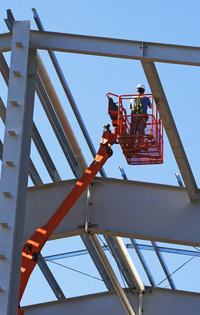 Cherry pickers – also known variously as elevated work platforms, basket cranes or man lifts – are movable access platforms that can be extremely useful for working at height. Mounted onto a truck, these machines provide high level access for many commercial applications including maintenance and cleaning, roofing and guttering, construction and tree surgery, to mention a few.
Cherry pickers – also known variously as elevated work platforms, basket cranes or man lifts – are movable access platforms that can be extremely useful for working at height. Mounted onto a truck, these machines provide high level access for many commercial applications including maintenance and cleaning, roofing and guttering, construction and tree surgery, to mention a few.
When it comes to safety, it only takes a brief look at the latest health and safety statistics to see that working at height contributes hugely to injuries at work. In fact, falls from height are the biggest cause of fatal injury in workplaces in the UK.
Choosing the right equipment for elevated access work is key. In many situations, using a cherry picker is not only the quickest, cheapest and least intrusive alternative to scaffolding platforms or towers, it can also be the safest option by far.
That said, as a baseline it is highly recommended to observe these four safety tips before operating a cherry picker.
- Check ground conditions
Before working with a cherry picker, make sure that the ground is level and suitable to work on. You shouldn’t use a cherry picker:
- On unstable ground
- On sloping ground (more than 5 degrees incline)
- In high winds or extreme cold
- During thunderstorms, due to the risk of lightning strikes
- Near power lines, in case of entanglement
- In the dark
- While exceeding the maximum load, due to the risk of toppling over
- Don’t take risks
A cherry picker is a movable platform to help with a wide range of high level access tasks. For your own personal safety, it’s important to stay within the parameters of the harness and working platform at the top of the equipment. Due to the heights involved, a serious fall from a cherry picker may lead to more than just a broken ankle – it can be fatal.
You may be tempted to overreach while carrying out your activity from the platform, perhaps while pruning trees, but don’t underestimate for a moment how dangerous this can be. This is no place for heroics or risk taking - much safer to move the cherry picker from place to place to obtain access.
- Carry out a risk assessment
It goes without saying that a full risk assessment should be carried out for any job where a cherry picker will be used, and a fall protection system should be in place. Accidents involving cherry pickers mainly occur as a result of:
- Mechanical equipment failure
- Unsuitable ground conditions
- Serious falls
- Contact with other vehicles
One aspect that is always notoriously difficult to assess is the human element. People will do stupid things without warning, and their unexpected actions can have far reaching consequences. If at all possible, make sure other distracting personnel is kept well away from the cherry picker operation, or ensure they are included in your safety plan.
- Provide adequate training
Health and safety training, including specific working at height training, is obviously essential – however there is a huge difference in training operatives to safely use static high level access equipment such as ladders, platform and scaffold towers, and working on a moveable elevated platform such as a cherry picker.
All cherry picker operatives must be fully trained beforehand, to ensure that they are fully conversant with the operation of the machinery along with all the relevant safety precautions. Regular training updates are particularly important for those who only work with cherry pickers occasionally, for the health and safety protection of everyone, whether up high or on the ground.
Author bio
Article provided by Mike James, an independent content writer working together with Sussex-based cherry picker hire company MC Property Maintenance, who were consulted over the information in this post.